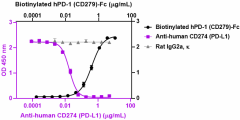- Clone
- W20262F (See other available formats)
- Regulatory Status
- RUO
- Other Names
- CD274, Programmed cell death 1 ligand 1 (PD-L1), B7 homolog 1 (B7h1)
- Isotype
- Rat IgG2a, κ

-

Biotinylated human PD-1 (CD279)-Fc chimera (Cat. No. 799504) (black circles) binds to immobilized recombinant human B7-H1 (PD-L1, CD274)-Fc chimera (Cat. No. 762504). Ultra-LEAF™ purified anti-human CD274 (B7-H1, PD-L1) (clone W20262F) (purple squares) inhibits the binding in a dose-dependent manner, whereas the Ultra-LEAF™ purified rat IgG2a, κ isotype control (Cat. No. 400544) (gray triangles) does not have effect. This antibody blocks the binding of 2 µg/mL biotinylated human PD-1 (CD279)-Fc chimera to 1 µg/mL immobilized recombinant human B7-H1 (PD-L1, CD274)-Fc chimera. ND50 range: 9 - 60 ng/mL.
| Cat # | Size | Price | Quantity Check Availability | ||
|---|---|---|---|---|---|
| 629553 | 100 µg | $415.00 | |||
| 629554 | 1 mg | $1040.00 | |||
Select size of product is eligible for a 40% discount! Promotion valid until December 31, 2024. Exclusions apply. To view full promotion terms and conditions or to contact your local BioLegend representative to receive a quote, visit our webpage.
PD-L1, a member of the B7 family, is a type I transmembrane protein of 290 amino acids. Human PD-L1 has 70% amino acid identity to its mouse orthologue. Binding of PD-L1 to its receptor PD-1 leads to the inhibition of T cell receptor–mediated lymphocyte proliferation and cytokine secretion. PD-L1 induces IL-10 production in T cells stimulated with low levels of anti-CD3. PD-L1/PD-1 interaction suppresses immune responses against autoantigens and tumors and plays an important role in the maintenance of peripheral immune tolerance. Disruption of the PD-L1 gene leads to up-regulated T cell responses and the generation of self-reactive T cells. Antibodies against PD-1 or PD-L1 leads to increased antitumor immunity. PD-L1 has an important role in conferring fetomaternal tolerance in an allogeneic pregnancy model. Antibodies against PD-L1 lead to a breakdown in maternal tolerance to the fetus. PD-L1 shares its receptor with PD-L2 (CD273, B7-DC). PD-L2 has a more limited expression than PD-L1, being expressed on activated macrophages and dendritic cells. PD-L1 is expressed in many tumors, and the interaction with its receptor activates signaling pathways that inhibit T-cell activity and therefore the antitumor immune response. Antibodies targeting PD-1 or PD-L1 block the PD-1 pathway and reactivate T cell activity.
Product Details
- Verified Reactivity
- Human
- Antibody Type
- Monoclonal
- Host Species
- Rat
- Immunogen
- Recombinant B7-H1 (PD-L1, CD274)-Fc
- Formulation
- 0.2 µm filtered in phosphate-buffered solution, pH 7.2, containing no preservative.
- Preparation
- The Ultra-LEAF™ (Low Endotoxin, Azide-Free) antibody was purified by affinity chromatography.
- Concentration
- The antibody is bottled at the concentration indicated on the vial, typically between 2 mg/mL and 3 mg/mL. To obtain lot-specific concentration and expiration, please enter the lot number in our Certificate of Analysis online tool.
- Storage & Handling
- The antibody solution should be stored undiluted between 2°C and 8°C. This Ultra-LEAF™ solution contains no preservative; handle under aseptic conditions.
- Application
-
Block - Quality tested
- Recommended Usage
-
Each lot of this antibody is quality control tested by blocking the binding of 2 µg/mL recombinant biotinylated Human PD-1 (CD279)-Fc chimera (Cat. No. 799504) to immobilized 1 µg/mL recombinant human B7-H1 (PD-L1, CD274)-Fc Chimera (Cat. No. 762504). ND50 range: 9 - 60 ng/mL. It is recommended that the reagent be titrated for optimal performance for each application.
- RRID
-
AB_3097541 (BioLegend Cat. No. 629553)
AB_3097541 (BioLegend Cat. No. 629554)
Antigen Details
- Structure
- Dimer
- Distribution
-
APC, monocytes, dendritic cells, expressed in nonlymphoid tissues, and stromal cell
- Function
- Enhances CD28-independent T-helper cell function, suppresses immune responses against autoantigens, and participates in fetomaternal tolerance
- Interaction
- Antigen-stimulated T and B cells, regulatory T cells, follicular T and B cells, dendritic cells, and monocytes
- Ligand/Receptor
- PD-1 (CD279)
- Cell Type
- Astrocytes, Dendritic cells, Fibroblasts, Granulocytes, Macrophages, Monocytes, NK cells, T cells
- Biology Area
- Cancer Biomarkers, Costimulatory Molecules, Immunology
- Molecular Family
- Adhesion Molecules, CD Molecules, Immune Checkpoint Receptors
- Antigen References
-
- Dong H, et al. 1999. Nat Med. 5:1365-9.
- Freeman GJ, et al. 2000. J Exp Med. 192:1027-34.
- Latchman Y, et al. 2001. Nat. Immunol. 2:261-8.
- Latchman YE, et al. 2004. Proc. Natl Acad Sci. USA. 101:10691.
- Guleria I, et al. 2005. J Exp Med. 202:231-7.
- Lin DY, et al. 2008. Proc Natl Acad Sci. USA. 105:3011.
- Dai S, et al. 2014. Cell Immunol. 290:72-9.
- Melero I, et al. 2015. Nat Rev Cancer. 15:457-72.
- Gene ID
- 29126 View all products for this Gene ID
- UniProt
- View information about CD274 on UniProt.org
Other Formats
View All CD274 Reagents Request Custom Conjugation| Description | Clone | Applications |
|---|---|---|
| Ultra-LEAF™ Purified anti-human CD274 (B7-H1, PD-L1) | W20262F | Block |
Compare Data Across All Formats
This data display is provided for general comparisons between formats.
Your actual data may vary due to variations in samples, target cells, instruments and their settings, staining conditions, and other factors.
If you need assistance with selecting the best format contact our expert technical support team.
-
Ultra-LEAF™ Purified anti-human CD274 (B7-H1, PD-L1)

Biotinylated human PD-1 (CD279)-Fc chimera (Cat. No. 799504)...
